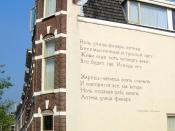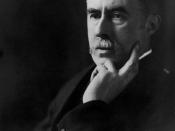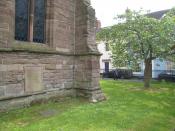In his poem, 'The Loveliest of Trees', A. E. Housman takes us through a sort of progression, if you will, from youth to age in three brief stanzas. I appreciated this poem for its simplicity and symbolism, as well as the underlying meaning hidden between the lines.
The first symbols I encountered in this poem were the colors. The cherry tree is blooming lovely in the spring, 'Wearing white for Eastertide'. Its fruit is at the peak of ripeness, rich and red, the color of blood, fire and passion. I feel this color could easily symbolize the life flowing inside the author, the fire stirred up in the mind of the poet who is, at the tender age of twenty, already lamenting over the lost years of his life.
Now of my threescore years and ten
Twenty will not come again
And take from seventy springs a score
It only leaves me fifty more
Red is the color of passion that the author has in his quest to see all things in bloom, actual and figurative, and his deep desire to spend the remainder of his years soaking up all the beauty he can in this world before his life is done.
It is a view I can appreciate, but one has to wonder where such a young man acquired this higher plane of thinking with such limited life experience.
White, however, is the color of purity and innocence. This could represent youth, which is 'hung with bloom along the bough' in the spring of life, then changes at the end of the poem to another symbol, as the author says 'About the woodlands I will go, to see
the cherry hung with snow', still the same colors, although in a different form of its life stage. The cherry...



Loveliest of Trees
The beautiful poem you write about is one of the first I memorized as a very small child. Housman is saying something more than merely that life is short and that we should make the most of it. He is specifically addressing the beauty of Nature which might easily be overlooked as we pursue our busy lives seeking material things. However, the cherry tree is symbolic of more than simply the beauty of Nature which should be enjoyed while we can.
Christians may discern a deeper meaning in Housman's poem. Housman found it difficult to reconcile his homosexuality with "traditional" Christianity and struggled mightily to find inner peace. Easter is the most important Christian holiday, more important even than Christmas, and it may be no coincidence that Housman refers to the cherry tree in connection with Eastertide. The cherry tree takes on almost a spiritual significance and contemplating the beauty of Nature can lead to a sort of spiritual enlightenment as we ponder the origin of such wondrous beauty. As you point out, white is indeed symbolic of purity, just as red symbolizes blood. As we mortals age, we pass from life to death. Easter commemorates the one that was innocent as snow who passed from death to life and through His blood sacrifice on a "tree" made it possible for us who accept Him to live forever.
We aren't given forever to make the choice. Christians believe that if we are to pass from death to life everlasting we must accept Jesus as our personal savior. And we must make that choice while we still live, for once we die it is too late to choose. Many never make that choice while they can, and could there be any greater lost opportunity than that? Housman took to his grave the secret of whether he accepted through faith the free gift of salvation and I can only hope that he chose wisely.
6 out of 6 people found this comment useful.